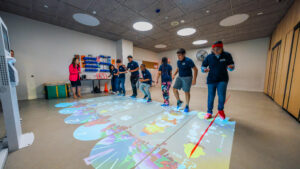Author: admin

Spotlight: Nicole Fitch, SBL of Cougar Mountain & Bellevue!
/ | Leave a CommentWe’re proud to spotlight Nicole Fitch, a dedicated educational leader whose career has been shaped by a deep commitment to students, families, and school communities. With more than 25 years of experience in education, Nicole has served in a wide range of roles, including teacher, instructional coach, assistant principal, principal,…
Read more »
Thanksgiving Feast 2025: A Photo Recap
/ | Leave a CommentWe celebrated one of our favorite traditions this month, the annual Thanksgiving Feast! Students helped serve lunch, and everyone — teachers, staff, and students alike — gathered around decorated tables to share a meal together. The day was filled with crafts, music, dancing, and the kind of joy that reminds…
Read more »
Welcome Dan McKeon, NY Regional Director!
/ | Leave a CommentWe’re excited to formally welcome Daniel J. McKeon, Regional Director of Gersh Autism Academy’s New York campuses, who joined us at the start of this school year. With more than two decades of experience in school and district leadership, higher education, and public service, Dan brings a wealth of knowledge…
Read more »
Growing with Gersh: Maureen Miller, Director of Educational Operations
/ | Leave a CommentWe’re thrilled to celebrate Maureen Miller, Director of Educational Operations at Gersh Autism Academy! Maureen’s journey is a true Gersh story, one rooted in growth, dedication, and heart. She began her teaching career at Gersh in 2014 and has called it home ever since, growing from classroom teacher to Curriculum…
Read more »
Welcome Paula Mack, SBL of Brooklyn!
/ | Leave a CommentPaula Mack is a passionate and experienced school building leader dedicated to empowering students, families, and educators through equity-driven leadership. With a strong track record as a Principal and Leading Schools in New York City elementary schools, she specializes in fostering inclusive, high-achieving environments that connect home, school, and community. …
Read more »
Growing with Gersh: Nadege Innocent, Manager of Admissions
/ | Leave a CommentAt Gersh Autism Academy, we believe that growth is something we all share—our students, our programs, and our people. Few stories reflect that spirit more than Nadege Innocent’s. Nadege began with Gersh more than 10 years ago as an agency para, quickly moving into a Gersh para role and then…
Read more »
Bringing Movement to Life: How Didim Is Changing the Way Our Students Learn and Play
/ | Leave a CommentAt Gersh Autism Academy and our Powered by Gersh schools, we are always seeking tools that engage our students while helping them grow, in mind, body, and confidence. This year, we’ve introduced Didim, an innovative, interactive movement system, to multiple campuses, including our AYM in Queens—a Powered by Gersh school—and…
Read more »
Educational Rights in Washington State: What Parents of Children with Autism Should Know
/ | Leave a CommentNavigating the special education system can feel overwhelming, especially when you’re trying to understand the laws, timelines, and processes that affect your child’s education. As a parent of a child with autism in Washington State, you have powerful legal protections under both federal and state law. But knowing those rights…
Read more »
Welcome April Stavropoulos, Junior Chief of Staff!
/ | Leave a CommentWe’re thrilled to welcome April Stavropoulos as the new Junior Chief of Staff at Gersh Autism Academy! April brings a strong background in operations, staff development, and organizational planning — all with a focus on building systems that help both students and staff succeed. Throughout her career, April has focused…
Read more »
Growing with Gersh: Celeste Gagliardi, Chief Education Officer
/ | Leave a CommentWe’re thrilled to share that Celeste Gagliardi has been promoted to Chief Education Officer at Gersh Autism Academy. Celeste has been a part of Gersh for over a decade, beginning her journey in 2012 as Executive Director and Principal. Under her leadership, Gersh Autism Academy West Hempstead campus grew from…
Read more »